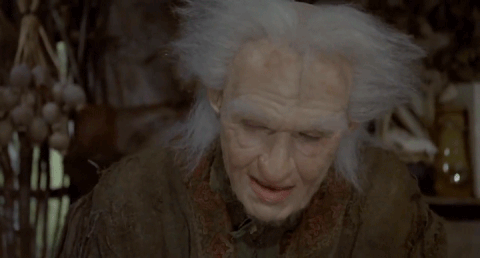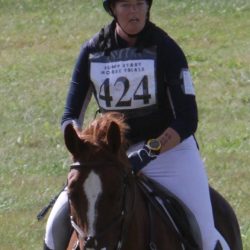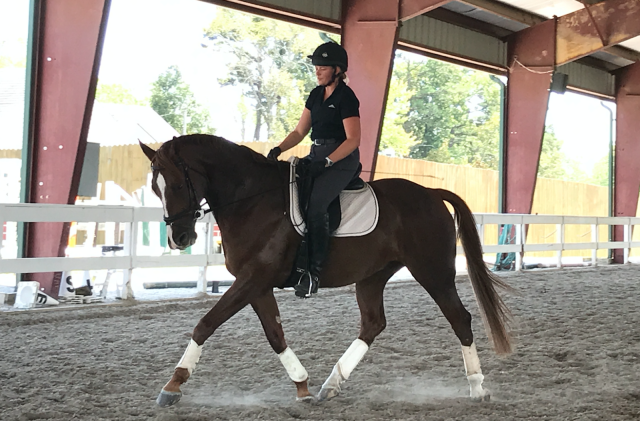
Diane and Art Bird volunteering at the Maryland Horse Trials. Photo courtesy of Diane Bird.
If you’ve ever been to an event — from a local combined test to the Land Rover Kentucky Three-Day — you know the volunteers make the show happen. They’re right in front of you with a clipboard telling you how many rides are in front of you and they’re tucked away behind the scenes helping the office staff. They’re handing out water, keeping track of your cross country time, putting up rails, and stuffing goodie bags.
Volunteers are integral to our sport, and if anyone deserves an extra shout-out, it’s Diane Bird. Diane was awarded the 2019 Sunsprite Warmbloods Volunteer of the Year at last month’s USEA Annual Meeting & Convention, having logged an astounding 307.5 volunteer hours at USEA recognized events this year. In addition to all the respect from everyone, she received $1,000, a “2019 Volunteer of the Year” embroidered jacket, and a trophy.
Diane has logged 639 volunteer hours since the USEA Volunteer Incentive Program launched on Dec. 1, 2016. Her total is second only to that of Michael Smallwood, who with 701 hours leads the overall standings out of 5,011 volunteers who have logged a total of 96,563 hours. Well-done to all of you volunteers out in the Eventing Nation!
Before moving to Aiken, this unstoppable volunteering force of nature and her husband, Art [who himself ranks 4th in overall standings, with 538 hours], lived in New Jersey where she was an elementary school science teacher for 25 years. It was there that a colleague showed her how to make stained glass — something she’s turned into a business.
After she retired from teaching, they moved to a farm in Lexington, Virginia, a stone’s throw from the Virginia Horse Center. By this time, they’d become interested in eventing and before long, they’d become great friends with Brian and Penny Ross and were put on the organizing committee for all eventing at the venue. After some time, their farm got to be too much for them to take care of, and they along with their corgis, Millie and George, decided to move to Aiken, South Carolina, where they live just a few minutes from the barn where they board their horses.

Diane and Willie with Art at the Virginia Horse Center. Photo courtesy of Diane Bird.
We asked Diane to share some volunteer wisdom and stories with us!
EN: How and when did you first get into riding and eventing? What drew you to the sport and what’s kept you interested?
DB: My sister introduced me to horses when I was six years old – took me for pony rides at our local riding stable. I soon graduated to riding by myself and got my first horse at age 14 – just rode the livery horses until then for $2/hour! I cleaned my mom’s and my aunt’s houses on weekend mornings to earn the $40.00 monthly board. (This sure dates me!!!!) I sold my horse when I went to college and did not get another one until I was 31, although I still rode whenever I had the opportunity.
I have never evented myself – have always just been a pleasure/trail rider. Hubby and I have been volunteering for 31 years. We watched the 1984 Olympics in LA, which got us interested in eventing, and attended our first event at Chesterland in 1986, just as spectators. Our first volunteering effort was in 1988 in NJ at a local show. We have been volunteering ever since. We love the sport and the people involved in it. Many of our lifelong friends are from the eventing world – officials, organizers, volunteer coordinators, competitors and fellow volunteers.
EN: When did you first start volunteering?
DB: 1988. We basically volunteer in Area II and III. Area III keeps us very busy all through the year, but we still go up to the spring and fall events at Virginia Horse Trials and the July event at Maryland Horse Trials. We did cross country fence judge jump #7ab at the WEG in Tryon.

Diane and Art volunteering at the 2018 World Equestrian Games in Tryon, North Carolina. Photo courtesy of Diane Bird.
EN: What’s the hardest part about volunteering at an event?
DB: Listening to the cross country briefing. We probably have been to hundreds of briefings over our 30 years of volunteering. I help with briefing newbies at several events myself, and it just gets old hearing the same old thing over and over. I know it is a necessity, but can’t help it if I tune out.
EN: What’s the best part about volunteering at an event and what’s your favorite job to do?
DB: I will do anything but bit check. I love dressage scribing since I learn something new every time. Favorite is probably starting cross country because I get to talk to all the competitors. Best part of volunteering is becoming part of the event family at a venue and making sure that the event is running smoothly for everyone there.
EN: Craziest thing that’s ever happened while you were volunteering?
DB: Up at the Maryland Horse Trials, we were starting cross country. A young competitor got eliminated through refusals and absolutely refused to be eliminated. She kept going, screaming that she had paid her money and was going to finish. (Along with many expletives!!) Roger Haller was the TD and took off in his golf cart after her, but she blew right by him, too. First and only time I ever saw Roger not taken seriously!
A close second: having to finish time cross country without a radio or announcer (so didn’t know who was on course), and no pinnys, just small dressage numbers on the horses. I had to call out to each rider who finished and ask them who they were.
EN: What is it about volunteering that makes you go back time and time again?
DB: The people – organizers, officials, riders, volunteers. Eventers are generally good people.
EN: What do you say to someone who wants to volunteer, but is scared they’ll make a mistake that impacts a rider?
DB: Start at schooling shows. Learn all you can about the position that you are going to fill. Listen to that briefing, and don’t be afraid to ask questions. Don’t move up to FEI events until you feel confident at the lower levels.

Well-deserved Volunteer of the Year Awards! Photo courtesy of Diane Bird.
EN: How can we get more people to volunteer at shows?
DB: The USEA Volunteer Incentive Program is a big help. Makes it easier for volunteer coordinators to keep track of people, and the new medal system should help interest more people. Many of the shows give perks to their volunteers like schooling passes, t-shirts, travel mugs, etc. Several venues here in Aiken throw end of the season parties for their volunteers. All these things are appreciated. Feeding volunteers well at the shows is mandatory, as well as making them feel appreciated. We appreciate a well organized show so I am sure so do most volunteers. So organizers and volunteer coordinators need to have their ducks in a row and marching along.
EN: Tell us about your horses, past and present!
DB: First horse was a strawberry roan Quarter Horse gelding named Sancho – he taught me much! Fancy, a liver chestnut Canadian Quarter Horse mare, and Shannon, a bay Thoroughbred mare, lived with us in New Jersey and made the move to Virginia with us. Both lived well into their late 20s. Pongo, a no-spot leopard appy gelding, was a gift from a dear friend in Florida.
We adopted two OTTB geldings, gray Orie and black Kenny, while in Virginia. Willie (“High Fly”), a chestnut Polish Arabian gelding, was my horse of a lifetime. We competed at low level dressage classes at the Virginia Horse Center, and he was the love of my life (along with hubby and Gumby [her beloved first corgi]) until I lost him to cancer, Cushings, and founder. I still miss him terribly.
We found Skippy, a chestnut Quarter Horse gelding, in Florida through the friend who had given us Pongo, and purchased Peylone, a paint/draft cross mare, from a friend in Lexington. I bought Flame, a white Arabian mare, after I lost Willie. We did compete in low level dressage shows in Virginia.
Orie, now 24, Skip, almost 30, Flame and Peylone, both 20, made the trip to South Carolina with us and are now boarded at Chime Ridge Stable in Aiken. Orie and Skip are both retired, and we pleasure ride Flame and Peylone.

Flame and Diane at the Virginia Horse Center. Photo courtesy of Diane Bird.
EN:What’s next for you in 2020??
EN: Volunteering, of course! Hope to get a few health problems straightened out and be able to ride more, maybe take the mares to Hitchcock Woods a few times. We plan to continue to care for our corgis as well as continue to working with several groups that help transport rescue dogs from high kill shelters to fosters or permanent homes – we have been doing that for about five years now and find it most rewarding!
We both enjoy gardening and have almost an acre of gardens at our home, so that keeps us busy. I’m also trying to keep up with my stained glass orders – I have been quite busy since moving here. (If you can’t sell horse stuff in Aiken, where can you sell it??) My brother and his wife moved to South Carolina right before we did, so we spend as much time with them as possible and hope to continue to do so. Hope to welcome some of our out-of-town friends to Aiken – love to have visitors.

Millie and George Bird. Must. Resist. Urge. To. Squeeze. Photo courtesy of Diane Bird.
Hopefully, Diane’s volunteer spirit has moved you to pick up some volunteer shifts — if she can log over 300 hours, surely you can volunteer at at least one show in 2020! You can check out the USEA Volunteer Incentive Program Volunteer leaderboard here and find more volunteering opportunities on EventingVolunteers.com. Once the season fires back up, you can also find available volunteer opportunities for each upcoming weekend via EN’s weekly “Volunteer Nation” series each Thursday.
Thank you, Diane, for all that you do and for showing all of us how it’s done! And cheers to all of our sport’s valuable volunteers — check out the top 20 of 2019 via the year-end leaderboard here.

Go Diane. Go Eventing.











































































